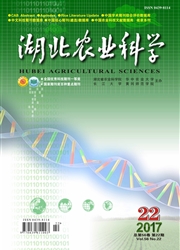

 中文摘要:
中文摘要:
为了了解徒骇河聊城城区段河岸带土壤重金属的含量和污染水平,测定了沿程20个河岸带土壤样品中重金属的总量和有效态含量,并采用富集因子法和潜在生态危害指数法对其污染状况进行了评价。结果表明,Cd、Cr、Cu、Ni、Pb和Zn的平均含量分别为0.185、50.4、28.7、23.5、28.7、88.2 mg/kg;各重金属有效态含量与其总量呈显著正相关,其所占总量的平均比例由大到小依次为Pb(38.1%)、Cu(31.9%)、Cd(30.1%)、Zn(17.1%)、Ni(10.1%)、Cr(4.2%);Cd、Zn、Cu和Pb表现为中等污染,Ni和Cr为轻微污染;总体表现为轻微的生态危害,其中Cd是主要污染因子和生态危害因子。采用相关分析和聚类分析法对污染源进行初步解析的结果表明,徒骇河岸带土壤重金属的人为污染源主要包括工业废水、交通运输、受污染的上游来水等。
 英文摘要:
英文摘要:
To explore the characteristics of heavy metal content of riparian soil along the Liaocheng urban section of Tuhai river,total and available contents of heavy metal were determined in 20 riparian soil samples.Using the soil background content of heavy metal in Shandong province as standards,enrichment factors and the potential ecological risk indices were calculated to assess the degree and the ecological risk of heavy metal contamination.The results showed that the average content of Cd,Cr,Cu,Ni,Pb and Zn were 0.185,50.4,28.7,23.5,28.7 and 88.2 mg/kg,respectively.The available contents of each heavy metal were significantly and positively correlated with the total content,and the average percentages of available contents in a descending order were as:Pb(38.1%),Cu(31.9%),Cd(30.1%),Zn(17.1%),Ni(10.1%),Cr(4.2%).The pollution of Cd,Zn,Cu and Pb was at middle level,and the pollution of Ni and Cr were at slight level.In general,heavy metal pollution in study area posed light potential ecological risk,and Cd was the main pollution and ecological risk factor.The source of heavy metal pollution was analyzed by person correlation analysis and hierarchical cluster analysis,and the results indicated that man-made pollution sources of study area included industrial waste water,traffic and transportation,contaminated water from the upper reaches and tributaries.
 同期刊论文项目
同期刊论文项目
 同项目期刊论文
同项目期刊论文
 期刊信息
期刊信息
